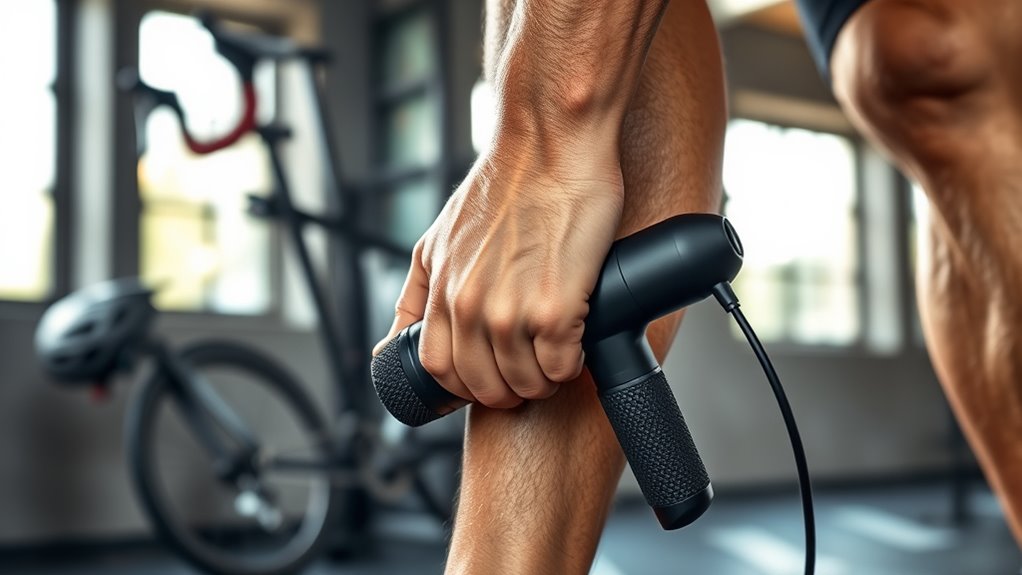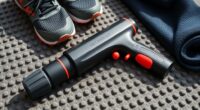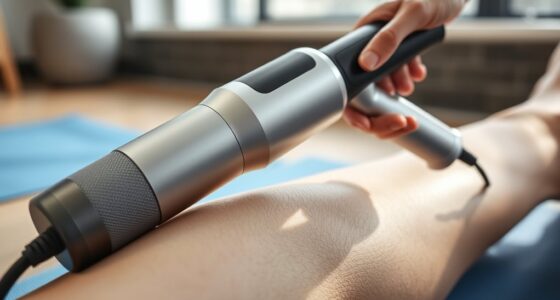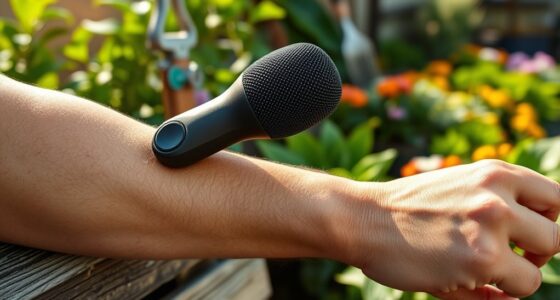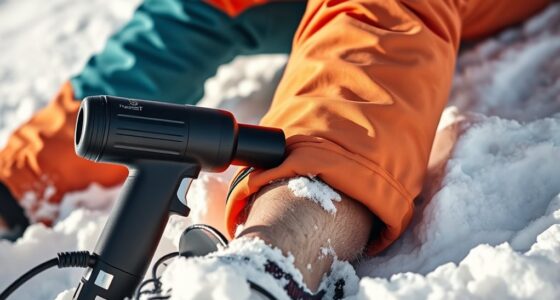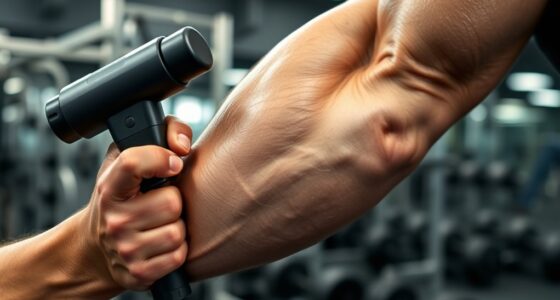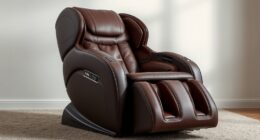Using a massage gun is a smart way to balance recovery after swim, bike, and run sessions. It helps boost blood flow, reduce muscle tension, and break down knots quickly, preventing injuries and speeding up your recovery. By targeting key muscles like calves, quads, and shoulders, you can stay consistent and perform at your best. Keep exploring to discover how to integrate massage guns into your overall triathlon recovery plan.
Key Takeaways
- Use massage guns on targeted muscles like calves, quads, hamstrings, shoulders, and back to support balanced swim, bike, and run recovery.
- Incorporate massage sessions post-training sessions to reduce muscle tension and stiffness across all three disciplines.
- Combine massage gun use with hydration, nutrition, and proper pacing for comprehensive recovery and performance optimization.
- Regularly target overused or stiff areas to prevent injuries and improve muscle elasticity for each triathlon segment.
- Schedule personalized massage routines aligned with training cycles to enhance endurance and maintain race readiness.
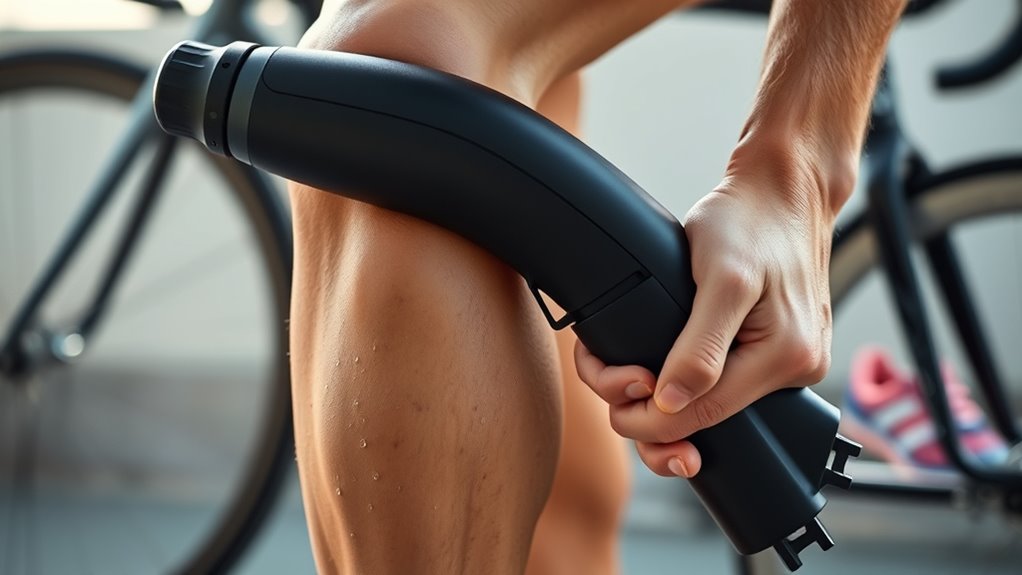
If you’re a triathlete aiming to maximize recovery and boost performance, massage guns can be a game-changer. After pushing through intense swim, bike, and run sessions, your muscles need targeted relief to recover effectively. Using massage guns isn’t just about soothing soreness; it can help improve your overall athletic performance by enhancing blood flow, reducing muscle tension, and preventing injuries. To get the most out of your recovery routine, it’s crucial to integrate massage guns with your competitive techniques, ensuring you stay ahead of your rivals. Combining massage therapy with strategic hydration strategies allows your body to flush out toxins and replenish lost electrolytes, which is essential during high-volume training periods. Hydration supports muscle elasticity and prevents cramping, making your recovery more efficient. When you use a massage gun, it’s best to focus on specific muscle groups that are heavily engaged during your workouts—like your calves, quadriceps, hamstrings, shoulders, and back. Applying targeted, controlled pressure helps break down knots and stiff areas, speeding up recovery and reducing the risk of overuse injuries. Incorporate your massage gun sessions into your post-workout routine, ideally as part of a broader recovery plan that includes proper hydration and nutrition. This synergy ensures your muscles are primed for the next training session, whether it’s a swim, ride, or run. Additionally, by aligning your massage gun use with strategic hydration strategies—such as drinking electrolytes or water before, during, and after workouts—you can maximize muscle recovery and maintain ideal performance levels. Keep in mind that consistent use of your massage gun can help you identify areas that need extra attention, allowing you to adjust your training and recovery strategies accordingly. Combining this with your competitive techniques, like pacing and proper nutrition, ensures you’re not just recovering but gaining an edge over your competitors. Remember, recovery is an ongoing process, and the sooner you incorporate massage gun therapy into your routine, the better your body adapts, reducing fatigue and enhancing endurance. As a triathlete, staying proactive about recovery means you’re more prepared to face intense training cycles and race day challenges. By paying attention to how your muscles respond and aligning your massage gun use with hydration and nutrition strategies, you’ll be able to sustain high performance levels, prevent setbacks, and keep your body race-ready. Ultimately, integrating massage guns with your overall training approach empowers you to recover smarter, perform better, and stay competitive throughout your season.
Frequently Asked Questions
Are Massage Guns Suitable for All Triathlon Training Levels?
You might wonder if massage guns suit all triathlon training levels. The answer is yes, but their effectiveness depends on your training intensity and recovery pace. Beginners can use them to ease muscle tension, while advanced athletes may rely on them for faster recovery after intense sessions. Adjust the massage gun’s settings to match your needs, ensuring you use it safely and effectively at any level.
How Often Should Triathletes Use Massage Guns During Training?
Imagine you’re training for a triathlon and wonder how often to use a massage gun. Follow the frequency guidelines—aim for 3-4 times a week, especially post-training. Keep usage duration around 15-20 minutes per session to prevent overuse. For example, after your long bike ride, a quick 10-minute session on sore muscles can aid recovery. Adjust based on your body’s response, listening for signs of fatigue or discomfort.
Can Massage Guns Prevent Injuries in Triathletes?
Using massage guns can help prevent injuries by reducing muscle tension and promoting blood flow, which aids in preventing overuse injuries. They also enhance muscle flexibility, making your muscles more resilient to strain. Regular use after workouts or training sessions allows you to target tight areas, decreasing the risk of strains and tears. Incorporating massage guns into your recovery routine supports overall injury prevention and keeps your muscles healthy and ready for the next session.
What Features Should I Look for in a Massage Gun?
Imagine a gentle breeze that soothes your muscles after a long day. When choosing a massage gun, look for adjustable massage intensity to match your needs, like a breeze turning into a gust. Long-lasting battery life guarantees your recovery isn’t interrupted, like a steady wind. Opt for a lightweight, ergonomic design for easy handling. These features help you customize your recovery, keeping you balanced across all your training efforts.
Are There Any Risks or Side Effects Using Massage Guns?
Using a massage gun can help reduce muscle soreness and improve recovery, but there are risks. You might experience skin irritation if you press too hard or use it on sensitive areas. Overuse can lead to bruising or muscle damage. Always follow instructions, avoid prolonged use on one spot, and stop if you feel discomfort. Being cautious guarantees you get benefits without risking skin irritation or other side effects.
Conclusion
So, next time your muscles scream for mercy, just whip out that massage gun. Who knew that a handheld device could turn your post-triathlon meltdown into a symphony of relief? Forget the fancy spa treatments—your trusty gun’s got your back, literally. It’s the secret weapon you didn’t realize you needed, making recovery so effortless that even your sore legs might start to envy your newfound relaxation. Triathlon recovery just got a whole lot smarter—and a little more fun.
